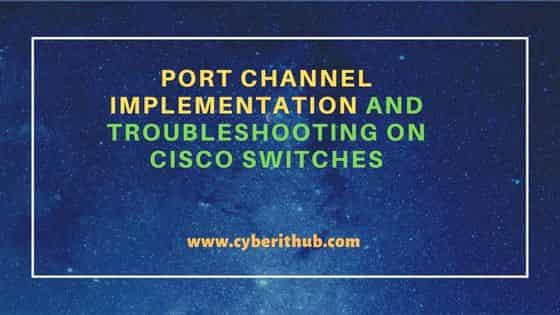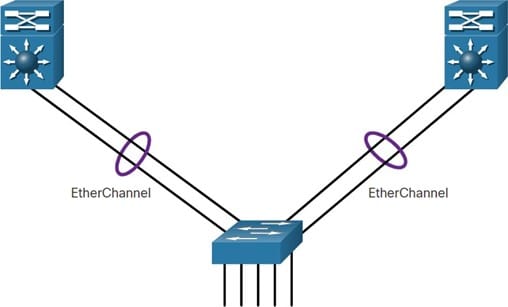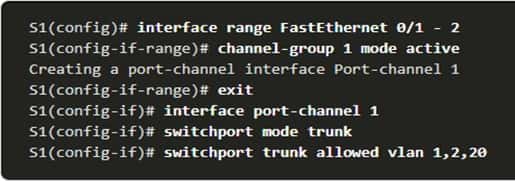Table of Contents
Port channel is one of the most important topics. Here we will discuss some scenarios in which more bandwidth or redundancy is needed between devices and that can be catered by a single logical link. Multiple links could be connected between devices to increase bandwidth. STP known as Spanning tree protocol which is active on layer 2 devices especially on cisco switches, it will block redundant links in order to avoid loop. A link aggregation technology is needed that allows redundant links between devices that will not be blocked by STP. That technology is known as EtherChannel.

Port Channel Implementation and Troubleshooting on Cisco Switches
Also Read: How to configure UDLD Protocol in Cisco Switches [Complete Tutorial]
EtherChannel is a link aggregation whose primarily function is to make on logical link of various groups of physical ethernet links. It is used to provide fault-tolerance, load sharing, increased bandwidth, and redundancy between switches, routers, and servers. EtherChannel technology makes it possible to combine the number of physical links between the switches to increase the overall speed of switch-to-switch communication.

EtherChannel or port channel, the concept was developed by Cisco as a LAN switch to switch technique which was grouping of several fast ethernet or Gigabit Ethernet ports into one logical channel. When an EtherChannel is configured, the resulting virtual interface is called a port channel. The physical interfaces are bundled together into a port channel interface, as shown in the figure.
Advantages of EtherChannel
EtherChannel technology has many advantages, including the following:-
- The configuration on Port channel is comparatively easy instead of on each individual port, ensuring configuration consistency throughout the links.
- EtherChannel relies on existing switch ports. There is no need to upgrade the link to a faster and more expensive connection to have more bandwidth.
- Load balancing takes place between links that are part of the same EtherChannel.
- Ether Channel do provide redundancy because the overall link is considered as one logical channel. It does not create loop or change in the topology. This technique is very useful in the switching and makes the life of a network administrator easy.
Implementation Restrictions
EtherChannel has certain implementation restrictions, including the following:-
- In Port channel there are some restrictions which must be followed. Let’s take an example, Fast Ethernet and Gigabit Ethernet can not be mixed with a single port channel. All ports must be the same either all should be Fast Ethernet ports, or all ports should be Gigabit Ethernet ports.
- Each EtherChannel can consist of up to eight compatible configured ports. They can have 8 Gbps full duplex bandwidth between one switch to another switch.
- The Cisco Catalyst 2960 Layer 2 switch currently supports up to six EtherChannel’s.
- The individual EtherChannel group member port configuration must be consistent on both devices. If the physical ports of one side are configured as trunks, the physical ports of the other side must also be configured as trunks within the same native VLAN. Additionally, all ports in each EtherChannel link must be configured as Layer 2 Ports.
- Each EtherChannel has a logical port channel interface. A configuration applied to the port channel interface affects all physical interfaces that are assigned to that interface.
EtherChannel’s or Port Channel can be formed through negotiation using one of two protocols:-
- Port Aggregation Protocol (PAgP)
- Link Aggregation Control Protocol (LACP)
These protocols do allow ports with having same characteristics while making port channel through dynamic negotiation.
Port Aggregation Protocol (PAgP)
Let’s have some explanation of the Port aggregation protocol. PAgP is a Cisco-proprietary protocol that aids in the automatic creation of EtherChannel links. When an EtherChannel link is configured using PAgP, PAgP packets are sent between EtherChannel-capable ports to negotiate the forming of a channel. When PAgP identifies matched Ethernet links, it groups the links into an EtherChannel. The EtherChannel is then added to the spanning tree as a single port.
When it is enabled, PAgP also manages the Ether Channel. This sent packets every 30 seconds. It also checks the configuration and manages the links additions and failures between the two switches. It also makes sure to have Port channel created and all ports are having the same type of configuration.
LACP is part of an IEEE specification (802.3ad) that allows several physical ports to be bundled to form a single logical channel. LACP allows a switch to negotiate an automatic bundle by sending LACP packets to the other switch. It performs a function similar to PAgP with Cisco EtherChannel. Because LACP is an IEEE standard, it can be used to facilitate EtherChannels in multivendor environments. On Cisco devices, both protocols are supported.
Link Aggregation Control Protocol (LACP)
LACP provides the same negotiation benefits as PAgP. LACP helps create the EtherChannel link by detecting the configuration of each side and making sure that they are compatible so that the EtherChannel link can be enabled when needed. The modes for LACP are as follows:-
- On : This mode forces the interface to channel without LACP. Interfaces configured in the on mode do not exchange LACP packets.
- LACP active : This LACP mode places a port in an active negotiating state. In this state, the port initiates negotiations with other ports by sending LACP packets.
- LACP passive : This LACP mode places a port in a passive negotiating state. In this state, the port responds to the LACP packets that it receives but does not initiate LACP packet negotiation.
LACP Mode Settings Example

The table shows the various combination of LACP modes on S1 and S2 and the resulting channel establishment outcome.
| S1 | S2 | Channel Establishment |
| On | On | Yes |
| On | Active/Passive | No |
| Active | Active | Yes |
| Active | Passive | Yes |
| Passive | Active | Yes |
| Passive | Passive | No |
Configuration Guidelines
There are some important guidelines and restrictions for configuring the port channel:-
- EtherChannel support : All the ethernet interfaces must support port channel as there should not be any problem in the physical layer of the interface.
- Speed and duplex : Configure all interfaces in an EtherChannel to operate at the same speed and in the same duplex mode.
- VLAN match : All interfaces in the EtherChannel must be in the same VLAN or should be act as trunking.
- Range of VLANs : An EtherChannel supports the same allowed range of VLANs on all the interfaces in a trunking EtherChannel. If the allowed range of VLANs is not the same, the interfaces do not form an EtherChannel, even when they are set to auto or desirable mode.
Configuring EtherChannel with LACP
Step 1: Specify the interfaces that compose the EtherChannel group using the interface range <interface_name> command in global configuration mode. The range keyword allows you to select several interfaces and configure them all together.
Step 2: Create the port channel interface with the channel-group <identifier> mode active command in interface range configuration mode. The identifier specifies a channel group number. The mode active keywords identify this as an LACP EtherChannel configuration.
Step 3: To change Layer 2 settings on the port channel interface, enter port channel interface configuration mode using the interface port-channel command, followed by the interface identifier. In the example, S1 is configured with an LACP EtherChannel. The port channel is configured as a trunk interface with the allowed VLANs specified.

Verify or Troubleshooting the Port Channel / EtherChannel
The steps which we have discussed are very simple and easy to configure the port channel. When you configure the device in your network, one should always check and verify the configurations. If there are some problems or errors, you need to understand and should be able to handle the problems or fix it. There are several commands to verify an EtherChannel configuration.
- The show interfaces port-channel command displays the general status of the port channel interface.
- The show interfaces EtherChannel command can provide information about the role of a physical member interface of the EtherChannel.
- The show EtherChannel summary command displays one line of information per port channel.
- The show EtherChannel port-channel command displays detailed information about a specific port channel interface.
All interfaces within an EtherChannel must have the same configuration of speed and duplex mode, native and allowed VLANs on trunks, and access VLAN on access ports. Ensuring these configurations will significantly reduce network problems related to EtherChannel. Common EtherChannel issues include the following:-
- Assigned ports in the EtherChannel are not part of the same VLAN, or not configured as trunks. Ports with different native VLANs cannot form an EtherChannel.
- Trunking was configured on some of the ports that make up the EtherChannel, but not all of them. It is not recommended that you configure trunking mode on individual ports that make up the EtherChannel. When configuring a trunk on an EtherChannel, verify the trunking mode on the EtherChannel.
- If the allowed range of VLANs is not the same, the ports do not form an EtherChannel even when PAgP is set to the auto or desirable mode.
- The dynamic negotiation options for PAgP and LACP are not compatibly configured on both ends of the EtherChannel.
